The NVIDIA GeForce GTX 650 Ti Review, Feat. Gigabyte, Zotac, & EVGA
by Ryan Smith on October 9, 2012 9:00 AM ESTOverclocking: Power, Temperature, & Noise
Our final task is our look at the overclocking capabilities of our GTX 650 Ti cards.
Because the GTX 650 Ti is based on a lower clocked GK106 we should have more headroom to play with. Furthermore because GPU Boost is not present, and hence NVIDIA is not min-maxing GPU clockspeeds in the first place, there should be even more headroom to play with. For overclockers dissatisfied with overclocking in the world of GPU Boost, the GTX 650 Ti is going to be a return to old fashioned overclocking.
As an added benefit, because GPU Boost is not present NVIDIA is not operating these cards so close to their 1.175v limit. While it’s true the 1.175v limit is still in place, with the average shipping voltage being nearly 0.1v below that limit there’s some overvolting headroom to play with that GeForce 600 cards don’t typically get to experience.
| GeForce GTX 650 Ti Overclocking | ||||||
| Ref GTX 650 Ti | EVGA GTX 650 Ti SSC | Zotac GTX 650 Ti AMP | Gigabyte GTX 650 Ti OC | |||
| Shipping Core Clock | 925MHz | 1071Mhz | 1033MHz | 1033MHz | ||
| Shipping Memory Clock | 5.4GHz | 5.4GHz | 6.2GHz | 5.4GHz | ||
| Shipping Load Voltage | 1.087v | 1.05v | 1.087v | 1.087v | ||
| Overclock Core Clock | 1175MHz | 1175MHz | 1175MHz | 1175MHz | ||
| Overclock Memory Clock | 6.6GHz | 6.6GHz | 6.6GHz | 6.6GHz | ||
| Overclock Load Voltage | 1.162v | 1.15v | 1.162v | 1.162v | ||
When we’re looking at cards similar to a reference design it’s not unusual for those cards to top out at similar clockspeeds. It’s not even rare to have two cards top out at the same spot. But it’s highly unusual to have all 4 cards top out at the same point: 1175MHz core and 6.6GHz memory. Despite our best efforts each and every card would fail 1200/6.7 at some point, forcing us back down to the clockspeeds you see above. Perhaps what is most interesting is that none of the factory overclocked cards managed to push higher than our reference card, or even higher than one-another for that matter. Given what we’re seeing it looks like GK106 is naturally capable of 1050MHz+ clockspeeds, so the amount of failed chips coming out of factory overclock binning should be minimal.
Oddities aside, these overclocks are quite good. Compared to the reference GTX 650 these clocks represent a 250MHz (27%) core overclock coupled with a 1.2GHz (22%) memory overclock. These are far greater overclocks than what we’ve seen on any other GeForce 600 series card to date, once again thanks to the fact that the GTX 650 Ti’s clockspeeds are so low due in large part to a lack of GPU Boost. Budget overclockers will almost certainly be quite pleased with the GTX 650 Ti, though it’s worth noting that its closest competition is the similarly overclocking-friendly 7850.
Moving on to our performance charts, we’re going to once again start with power, temperature, and noise, before moving on to gaming performance.
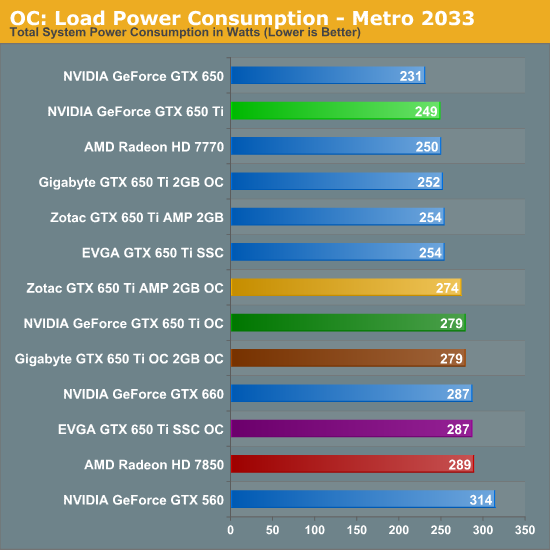
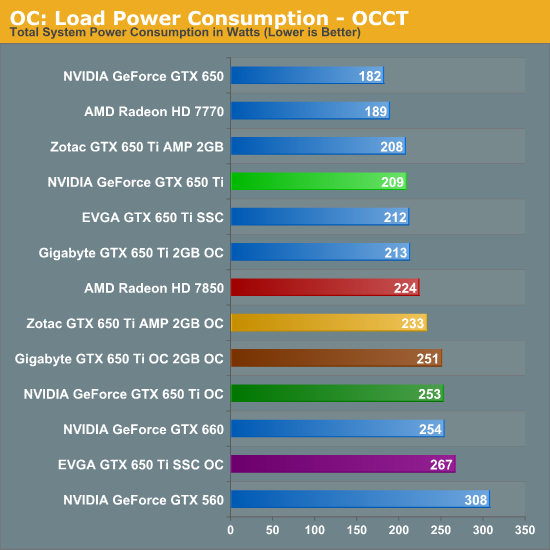
Unlike overclocking cards with GPU Boost, in the case of the GTX 650 Ti we are unquestionably overvolting the card. As a result the power consumption penalty for overclocking is quite harsh on a relative basis, though thankfully the GTX 650 Ti starts out low enough that the PCBs and the coolers are having no problem keeping up.
Overall, our overclocking efforts have pushed the power consumption of our GTX 650 Ti cards up by 30-40W, which puts power consumption just below the GTX 660 and 7850. The best performing card in this regard – that is, the card with the smallest increase in power consumption – is the Zotac card, followed by the close pairing of the Gigabyte card and the reference card, and finally EVGA’s card. This is one of those cases where a sample size of 1 just isn’t big enough, so there’s no clear reason why Zotac does so well or EVGA fares so poorly. Looking at temperatures it may be that we’re seeing temperature induced leakage, then again it may be that the hottest card is the hottest because of that power consumption.
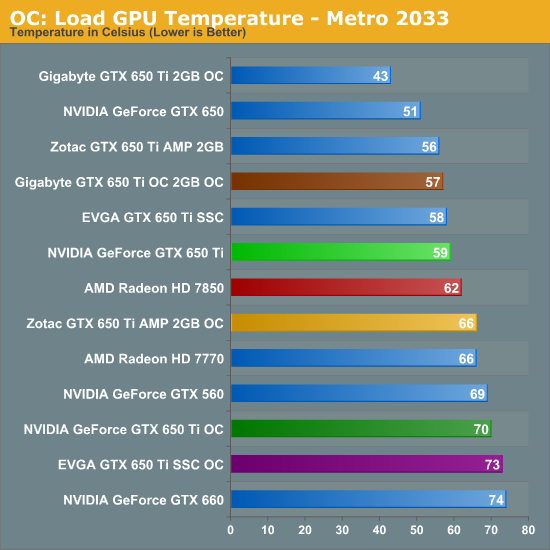
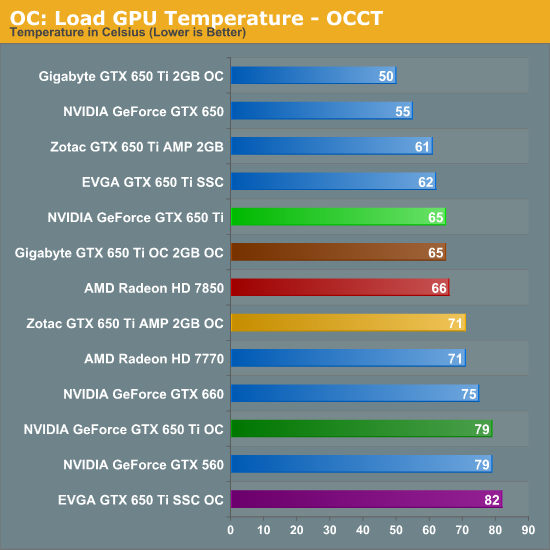
Next up is load temperatures. As we’ve already seen in our look at stock performance the Gigabyte card has a relatively aggressive fan curve, which is great for temperatures at the cost of noise. As a result even in the worst case scenario of OCCT it only hits 65C, 6C cooler than the next-closest overclocked card. That brings us to the Zotac card, which isn’t as cool as Gigabyte’s card but at 71C is still doing rather well. This is followed by the reference card at 79C, and finally the EVGA card at 82C.
Given the amount of power we’re channeling through these cards, it’s rather surprising just how well they hold up here. Even with these small coolers GPU temperatures are well into the safe zone, though the EVGA card is about as hot as we’d let such a card get under normal circumstances.
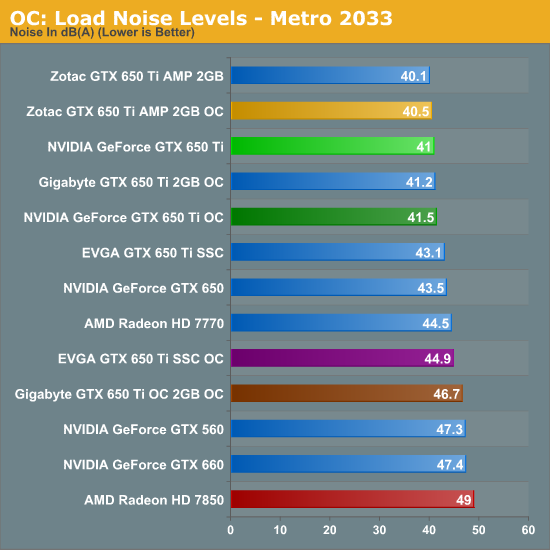
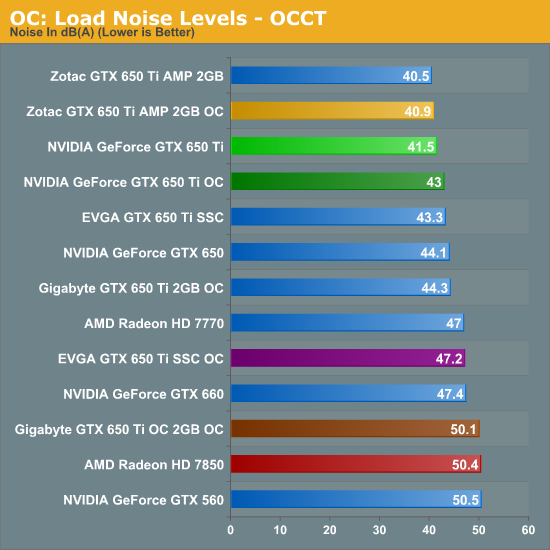
Moving on to noise, the cards that were previously doing well with stock settings continue to do well, while the rest of the cards fall further behind the leaders. The quietest card remains the Zotac, which even overvolted and running OCCT still doesn’t pass 41dB(A), which is simply incredible given the amount of power it’s pulling by this point. And as we’ve already seen its temperatures are respectable too, so Zotac seems to have hit the perfect balance here.
At the other end of the spectrum we have the EVGA and Gigabyte cards. Gigabyte continues to fall behind due to their aggressive fan curve, while the EVGA card and its poor overclocked temperatures require the card to push the fan even harder to keep up. Neither one of these cards is doing an acceptable job in light of what the Zotac card nor the reference card are achieving.










91 Comments
View All Comments
Galidou - Saturday, October 13, 2012 - link
I won't be back on that thread anymore but just wait for some more stupidly stubborn reply of Cerise, that guy is just a show by himself. His level of global consiousness is below anything I have yet to see in the whole world.Sure he has some knowledge, can't deny it, it's just used in a way that seems like all that potential is totally WASTED, thrown to the garbage, buried in vomit and so on.....
Funniest shit ever.... LOL funniest comments ever..... Can't beleive it.....
Speelteveel - Wednesday, March 13, 2013 - link
Please provide these benchmarks where the oc'd 650ti "flies" past the 7850.Its not a 50 buck price diff, its 20.
Also, in these benches above, the 7850 is not overclocked.
So basically, you advocate to pay $20 less for a card that you have to overclock to get similiar performance, when the $20 more expensive card when oc'd goes into another spectrum of perfomrnace that the 650ti can't even fathom. Oc'd 7850s break even with 7870 benchmarks at 1080p.
I'm not going to link you the benchmarks you can peruse google y yourself.
the 650ti can't compare to the 7850 at all. I'm no fanboy, I just found your post dissing fanboys while blatantly being blindly biased very amusing.
vbmluis - Friday, October 12, 2012 - link
Yeah, I remember one, ATi HD 2900, heavy, big, noisy, power hungry, pricey and low performance.Jamahl - Tuesday, October 9, 2012 - link
It's not bad. It's just slow, expensive and late.Samus - Tuesday, October 9, 2012 - link
lol, that defines bad, man!But I'd argue...the only thing really wrong with this card is there isn't any good reason or it to be dual slot. with that power envelope, nVidia really could have rocked the house if this thing were a single slot, maybe even half height card (especially the 650 non-TI) because it's make a very powerful USFF/ITX PC GPU.
Aside form my dream of this card being single slot, it isn't a terrible card. The 650 Ti is mostly on par with the old 560 (which still costs more) while using less power and being half the length. Pretty much a no-brainer which one to buy there. But neither card is really worth $150-$180 when you consider you get substantially more (25-40%) performance from the 660 for just 20% more monies.
Blazorthon - Tuesday, October 9, 2012 - link
Don't forget, the 7850 comes with games and so does the 7770. Coming with a game is necessary just to compete right now. The 7770 also has some highly factory overclocked models that can inch out the 650 Ti while still being cheaper. The 650 Ti would do better at $10 or $20 lower and a MIR is a great way to accomplish that since a lot of people forget to do them anyway, but buy the card because of the after MIR price.TheJian - Tuesday, October 9, 2012 - link
Love defending AMD everywhere you go don't you :)Until you OC the 650 (or buy one already done, you act like they don't sell them on both sides OC'd) making your point moot. No phsyx either.
http://www.geforce.com/games-applications/physx
Even batman AA supports it. I don't think the 7770 comes with a current AAA title such as Assassins Creed 3 (doesn't get any more current than a game NOT even out yet). That will make a nice xmas gift to themselves for anyone buying one. Metacritic has a date of Nov20th, which is plenty of time for them to even be late a few weeks an still play over the holidays.
I'd be more than happy to have another round like we did at Toms if you'd like :) You start claiming MSAA crap again and we'll have a go...LOL
Please refrain from saying AMD is financially competitive with Intel here like over at Tom's, I don't want to waste my time burying that one again...ROFL.
abianand - Wednesday, October 10, 2012 - link
I have a slight preference from AMD cards (I don't why and I don't like having a slight preference between two equally and fairly-competing brands).Having said that....
7850 is definitely faster, but look at the power consumption of the 650Ti. Even an overclocked 650Ti draws power that just equals a normal non-overclocked 7850. So, I wouldn't call the 650Ti a bad product at all, especially when it manages to touch 30fps in almost all settings in almost all games.
Samus - Wednesday, October 10, 2012 - link
I have a preference for nVidia drivers, but these days both companies make solid chips. The real problem for AMD is all the games I play (mostly EA games) are optimized for nVidia architecture...like how Source was optimized for ATI architecture.Just how it goes.
Death666Angel - Wednesday, October 10, 2012 - link
"Until you OC the 650 (or buy one already done, you act like they don't sell them on both sides OC'd) making your point moot."Wait, so you can't OC AMD cards? Oh that's right, you can. So that is meaningless, as any OC gains from Nvidia cards will be (likely) negated by OCing the respective AMD cards.